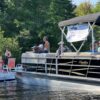Tom Atwell has been writing the Maine Gardener column at the Portland Press Herald and Maine Sunday Telegram since 2004. He recently did a nice article on the responsibilities we all have when owning lakefront property. Much of Tom’s information has be mentioned in some form on this website in the past. However, its great to see these ideas and others reinforced by a respected reporter outside the Watchic Lake community.
The full article is included here and can be access via the link below.
Good for you if you live by water, good for all if you don’t pollute
Check with your town or state environmental offices before making changes that could violate the law.
September 7, 2014 The Maine Sunday Telegram

Owners of waterfront property, like this one in Kittery Point, are advised by environmental specialists not to fertilize much, if at all, and to avoid using weed killers and insecticides, which damage the waterway and the life in it. Staff file photo
Owning a home on the waterfront comes with responsibilities, and I don’t mean that you’re already paying more real estate taxes for the view, and your relatives want you to host all the summer family reunions. As a waterfront homeowner, you are the partial caretaker of the body of water – lake, stream, river or ocean – and are responsible for helping it remain clean, strong and healthy.
The state has strict rules that regulate the creation of new landscapes on waterfront property. The first shoreland zoning law for Maine was passed in the early 1970s and has been updated several times since. (Find the state’s 42-page book detailing some of the regulations at maine.gov. Search for “Maine shoreland zoning.”) Landscapes created before shoreland zoning laws were enacted are grandfathered, which means they can be maintained but not expanded.
Shoreland zoning rules on new work vary from town to town, according to Jami Fitch of the Cumberland County Soil and Water Conservation District. For that reason, before doing anything you must contact your municipal code-enforcement office or, if you are in a smaller community, the state Department of Environmental Protection.
Generally, you are not allowed to remove vegetation within 100 feet of the body of water. The trees and other plants already there are protecting the soil from erosion caused by hard rain and wind. “You need that to hold the soil in place,” Fitch said. “Soil erosion is one of the largest pollutants.”
In addition, the plants next to the water provide habitat and food for the wildlife (and the animals were there before you were), which contributes to the health of the overall habitat – including the sea, lake or river.
You can make a few changes within that 100 feet. For example, she said, you can create and maintain a 3-foot wide path to the shoreline.
“We recommend that the path meander and have some curves so that it is not a straight shot to the water,” Fitch said. “That way rainfall has a chance to get off the path and soak into the ground before it reaches the resource.” Water running down the path could carry soil and sediment into the water.
Part of what many people like about living on the water is sitting on the porch sipping a morning coffee or evening cocktail and watching the passing birds and boats. You might think 100 feet of vegetation prevents that view, but that is not entirely true. With town or state permission, you can do some selective trimming, such as cutting the lower branches on some of the trees, to open up the view.
Gardeners everywhere are advised to get rid of invasive plants such as bittersweet, multiflora rose, Japanese knotweed or honeysuckle. But that is not always a good idea along the shoreline, because removing the plants would allow a lot more erosion, Fitch said. If you want to remove the invasives, contact the town first to get permission and advice for controlling erosion.
Fitch has advice for existing, grandfathered waterfront properties, too: “The first thing is to reduce the lawn size,” she said. That’s because lawns require more fertilizers and pesticides than other garden areas, and also don’t soak up as much water as gardens of native plants. (Again, you want the garden to soak up the water, both to slow erosion and prevent runoff from carrying contaminants into lakes, rivers or the sea.)
Install a variety of native plants to replace the lawn. The Soil and Water Conservation District (www.cumberlandswcd.org) and University of Maine Cooperative Extension (extension.umaine.edu) both have plant lists and will provide technical assistance. Ocean, lake and river frontage will have different requirements. Some sites are shady, others sunny. Some have sandy soil, others have more clay. The right plants will vary for each site.
“Everyone loves the idea to put in low-bush blueberries,” Fitch said, “but it is better to plant a mix of perennials and shrubs with different root depths. It is really important to create a good root mat to hold the soil in place.”
In addition, the mixed landscape looks a lot better, and if a pest comes around, it could decimate an area with just one type of plant but probably wouldn’t damage every plant in a garden with a wide variety.
For the lawn you do keep, don’t fertilize too much. Get a soil test to find out what your lawn needs, and look at the fertilizer labels. Phosphorous is the chemical that causes algae blooms in fresh water, while nitrogen is the problem for salt water. Most Maine gardens do not need phosphorous, plus there are many phosphorous-free fertilizers for sale.
Also, a survey done by the Maine Yardscaping Partnership released a few years ago said that most lawns over 10 years old don’t need fertilizing at all. Fitch concurred, but most lakeside lawn sites have sandy soil, so a test is still a good idea. Such soil does not have many nutrients, so may still need fertilization. A soil test will tell you. And while a living lawn is not great for a lake, a dead lawn would be worse.
At the same time, homeowners should avoid weed killers and insecticides along a waterfront, which can seriously damage the water, fish and other creatures that live there.
Owning a waterfront home is a dream that not everyone can reach. If you are lucky enough to own one, be a good steward. Remember that the rivers, lakes and ocean belong to everyone and do your part to ensure that the water your house abuts stays clean, healthy and beautifu
ABOUT THE WRITER
Tom Atwell has been writing the Maine Gardener column since 2004. He is a freelance writer gardening in Cape Elizabeth. Contact him at 767-2297 or at tomatwell@me.com.


